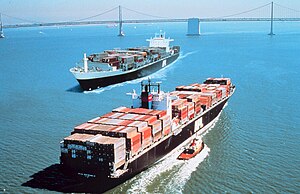Container ships

Two container ships pass each other
|
|
| Class overview | |
|---|---|
| Name: | Container ship |
| Subclasses: |
|
| Built: | 1956–present |
| In service: | 9,535 ships as of 2010 |
| General characteristics | |
| Propulsion: | Typically diesel since 1990 |
| Speed: | Typically 21–25 knots (38.9-46.3 km/h) |
| Capacity: | Up to 19,224 TEU |
| Notes: | Reduced superstructure, containers stacked on deck, bulbous bow |
|
|
|
|
|
Container ships (sometimes spelled ) are cargo ships that carry all of their load in truck-size intermodal containers, in a technique called containerization. They are a common means of commercial intermodal freight transport and now carry most seagoing non-bulk cargo.
Container ship capacity is measured in twenty-foot equivalent units (TEU). Typical loads are a mix of 20-foot and 40-foot (2-TEU) ISO-standard containers, with the latter predominant.
Today, about 90% of non-bulk cargo worldwide is transported by container, and modern container ships can carry over 19,000 TEU (e.g., MSC Zoe). Container ships now rival crude oil tankers and bulk carriers as the largest commercial vessels on the ocean.
There are two main types of dry cargo: bulk cargo and break bulk cargo. Bulk cargoes, like grain or coal, are transported unpackaged in the hull of the ship, generally in large volume. Break-bulk cargoes, on the other hand, are transported in packages, and are generally manufactured goods. Before the advent of containerization in the 1950s, break-bulk items were loaded, lashed, unlashed and unloaded from the ship one piece at a time. However, by grouping cargo into containers, 1,000 to 3,000 cubic feet (28 to 85 m3) of cargo, or up to about 64,000 pounds (29,000 kg), is moved at once and each container is secured to the ship once in a standardized way. Containerization has increased the efficiency of moving traditional break-bulk cargoes significantly, reducing shipping time by 84% and costs by 35%. In 2001, more than 90% of world trade in non-bulk goods was transported in ISO containers. In 2009, almost one quarter of the world's dry cargo was shipped by container, an estimated 125 million TEU or 1.19 billion metric tons worth of cargo.
The first ships designed to carrying standardized load units were use in the late 18th century in England. In 1766 James Brindley designed the box boat "Starvationer" with 10 wooden containers, to transport coal from Worsley Delph to Manchester by Bridgewater Canal. Before the Second World War first container ships were used to carrying baggages of the luxury passenger train from London to Paris, Golden Arrow/Fleche d'Or, in 1926 by Southern Railway. These containers were loaded in London or Paris and carried to ports, Dover or Calais, on flat cars in the UK and "CIWL Pullman Golden Arrow Fourgon of CIWL" in France.
...
Wikipedia
